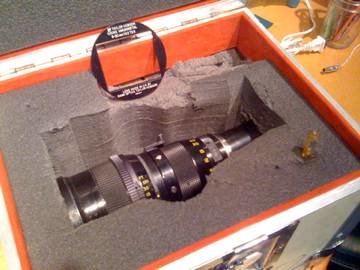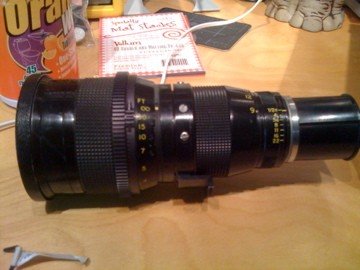
Mark Schlicher
Basic Member-
Posts
14 -
Joined
-
Last visited
Profile Information
-
Occupation
Cinematographer
-
Location
Nashville, TN USA
Contact Methods
-
Website URL
http://www.sunporchmedia.com
Recent Profile Visitors
The recent visitors block is disabled and is not being shown to other users.
-
WTB: KINOPTIK ORIENTABLE VIEWFINDER FOR ECLAIR ACL
Mark Schlicher replied to Giorgio Taricco's topic in Cine Marketplace
Did you ever find one to buy? I have one, in really nice condition. I'm based in the USA. -
$2295 including shipping to CONUS Time to part with my Cooke 9-50mm T=2.5 lens. Great for RED One at 2k or Scarlet. Covers regular 16mm and can be converted by ZGC to Super 16. http://www.zgc.com/webstore.nsf/products/zgc_zsconcooke Immaculate condition. Glass is pristine, no fungus, no dust, no scratches. All mechanics are silky-smooth. This is a personal lens that has never been rented out. I bought it a few years ago from a DP who used it as his personal lens. He had it fully serviced just before selling it to me, including having the witness marks repainted. I've periodically had it checked out and collimated on a lens projector. Always stored in proper conditions in its case. In the 8 years or so that I've had it, I've shot with it less than 5 times. Sale includes Anvil-style case with custom foam,and hard-matte. Has the legendary, much-desired warm, contrasty, Cooke "look." Extremely sharp edge-to-edge, and retains its sharpness wide open at a fast T=2.5. Almost no zoom breathing. Close focus to 1 foot 6 inches! Compact size. In stainless steel Arri bayo mount, easy to convert to PL. Focus gear included, front and rear caps, and I'll throw in a 4 1/2" round screw-in Tiffen collapsable rubber lens shade. Comes in anvil-style shipping case. If you are interested I have a zoom motor and bracket I can sell you separately, as well as a clamp-on 4 1/2 inch sunshade.
-
$80 plus shipping to lower 48. Barely-used Harrison Jumbo film changing tent by Camera Essentials. Harrison Jumbo Film Changing Tent. (48" X 28" X 19"). $250 at Film Tools. http://www.filmtools.com/harjumfilcha.html “Use this Harrison JUMBO Film Changing Tent for those 70mm 1000' mags, or if you just like the extra room, this bag works great for IMAX, Panavision and Movicam 1000' mags. Folds up easily into its own stuff sack. Made in USA by Camera Essentials.”
-
What on earth is happening to Steadicam
Mark Schlicher replied to Phil Rhodes's topic in General Discussion
With all due respect, the glut of low-end rigs and wannabe operators is not Tiffen's fault. When the original patents expired, two things happened: 1. High-end accessory makers like PRO-GPI began to manufacture complete systems, which appealed to high end operators on the basis of modularity, quality of design and manufacture, and customer service. 2. Low-end manufacturers began making (mostly crappy) equipment that appealed to indies and wannabies pretty much only on the price. Tiffen is not creating the glut of low-end systems on the market, and they did not create the demand. They have simply decided to compete in the lower end of the market with superior gear (and people in that segment still bitch that it is "too expensive" and buy Flycams instead). The downward push on rates is real and unfortunate, but would be absolutely no different if Tiffen had never offered the Flyer, Pilot, etc. There would just be more Glidecams and Flycams sold. Mark Schlicher, SOC -
I am parting with a gorgeous 16mm format Cooke 9-50 lens (covers Super 16 from 20-50). Stainess steel Arri bayo mount. Legendary Cooke sharpness and contrast. It's also lightweight. Glass is flawless, it's been well-maintained, and used very little by me. This is an exceptional example of this lens. Witness marks were professionally repainted when the lens was overhauled just prior to my purchasing it. Also comes with an Anvil-style case. I checked recently and Duclos has the Super 16 conversion kit if you wanted to go that way. I gather it would cost about $1200 parts and labor, and you'd end up with an amazing lens for Super 16. Or just use it like it is... $1700 OBO plus shipping. CONUS only.
-
For Sale: CP16R/A Super 16 (Hillman) conversion
Mark Schlicher replied to Mark Schlicher's topic in Cine Marketplace
Sorry, I don't have a picture handy and there is no manufacturer's name on the unit. Looks like maybe a custom job. -
I'm selling my super 16 camera package, a CP16RA that Paul Hillman from Visual Products converted. It has gotten very light use since then (less than 15 rolls run through it), and is in pristine condition. I shoot nothing but HD these days. Camera looks good, and all functions are excellent. Extremely quiet. I doubt that it would even need a tuneup (but it's always recommended). It's been babied in use and stored carefully. All lens and body caps, Pelican 1650 case. Includes: Cinema Products lens mount with stainless steel Arri bayo converter 156 degree shutter modification to allow either 24fps crystal or 30fps crystal operation non-sync 12-36 fps standard viewfinder (non-orientable) 3 PLC-4a mags with cores 10-150 Angenieux lens (not super 16 converted) arri bayo mount, exc condition J5 zoom control handle and motor video tap port and video tap system with monitor (3rd party system, not tiny but not the big CP unit) 3 batteries (one was fairly recently recelled ) and two chargers AC adapter Stainless steel arri bayo-to-CP lens adapter Various accessories, spare belts, etc. $3500 plus shipping. Also available: Cooke 9-50mm t=2.5 zoom lens. super-16 convertable but not yet converted. Optically perfect. Arri bayo mount with anvil-style case and 4 1/2 round tiffen sunshade: $2100 +shipping. Kinoptik 5.7 wide angle lens in Arri standard mount with CP adapter in pelican case, very slight s cratch on front element: $500 + shipping. Please email with questions or to make offer. mark at sunporchmedia dot com
-
ATTENTION: Camera experts, I need your help!
Mark Schlicher replied to Matthew W. Phillips's topic in 16mm
Here's my rough understanding: Essentially most of the early news cameras were "chopped" auricons with 400 ft mitchell mags added on, and a lens with a viewfinder built into the lens (typically an Angenieux). Companies then started putting the auricon movements into their own housings but the movements were essentially identical. Cinema Products and Frezzi started that way. CP improved the mag with their PCL4 series, and added the reflex viewfinders. I used to have a great picture clipped out of a magazine, of John Waters shooting Pink Flamingos with a non-reflex CP16 with Mitchell mag slung on his shoulder. Ken Hale at Whitehouse AV can fill you in on more history, I would imagine. -
Scoopic M/MS cameras in good condition are good mos b-cameras, much better than the original scoopic. Optics are good, though the zoom range is limited. I had one a few years ago (about 8) and couldn't find anyone who could service mine properly. Parts are almost impossible to find. If you find someone who is servicing the camera they are possibly relying on cannibalized used parts. Unless you need the small size, you might be better served by purchasing a CP16R (or R/A). Solid camera, chrystal sync, 400 foot mags, lots of parts available, competent techs (Ken Hale and Whitehouse AV, Paul Hillman at Visual Products), and the camera can be bought very inexpensively these days.The Scoopic M does have the advantage of shooting 64FPS but with 50 ft daylight spools it is not necessarily a pleasant experience in terms of constant reloads!
-
Sorry, late to the party, but... 1. Recelled batteries may last a little longer, because newer cell designs have somewhat higher capacities...something like 15-20 percent. 2. A battery in good condition, running a tuned-up camera, should last at least ten mags.
-
Hey, gang, it's not that hard! Loading the mags is a piece of cake. The trick is to crease the film lengthwise/diagnally for a couple of inches, before threading through the mag throat. The film winds in a "99" orientation in the mag. Load the feed side in the dark, the takeup side in the light. When threading the camera, pull a loop through the door and out to the handle. That will give you about enough film to work with. Back the claw out of the gate with the inching knob, seat the film, and run the claw back in to engage. Make sure your bottom loop is 1/8 inch from the botttom of the camera. Run a bit at 12fps to make sure that it doesn't touch the bottom of the cavity. The threading is no worse than an old 16mm projector, or a Panavision 35mm camera. The best books around for CP-relevent info are the 16mm Camera Book by Doug Underdahl, and Vern and Sylvia Carlson's "black book" The Cameraman's Handbook (I think that's what it's called). With practice you should be able to load a mag in a couple of minutes, and thread up a pre-loaded mag in less than a minute.
-
YMMV, but I had a bad experience with Whitehouse (a bungled overhaul) shortly after Paul Hillman left. I have also had good experiences with Whitehouse, and actually stopped in and met both Derrick and Ken when I was in California a few years back. But my bad experience was never resolved to my satisfaction. After that, I have used Paul at Visual Products exclusively, and I have been bowled over by his skill, honesty, and dedication to excellence. He did my S16 conversion and I have loved it. M
-
Only one choice, IMO. Paull Hillman at Visual Products. He invented the conversion and nobody does it better. PL mount if you want, and he also makes a really good video tap.
-
Paul Hillman at VP converted my CP to super 16. Mine was one of his first conversions, about five years ago, and it has served me well. Paul used to be the main tech at Whitehouse. While he was there he tried to get them interested in doing S16 conversions but they weren't interested. As far as I'm concerned, Paul invented the CP Super 16 conversion. He is the only tech I would allow to touch my CP, period. Not even Whitehouse, based on some less-than-stellar post-Paul experiences with Whitehouse. The "viewfinder" modification is actually a re-etching of the fiber-optic groundglass. Cavision makes some mattebox/rod systems for the XL1 that can be adapted to the CP16. You may need to call them to get the right setup.






